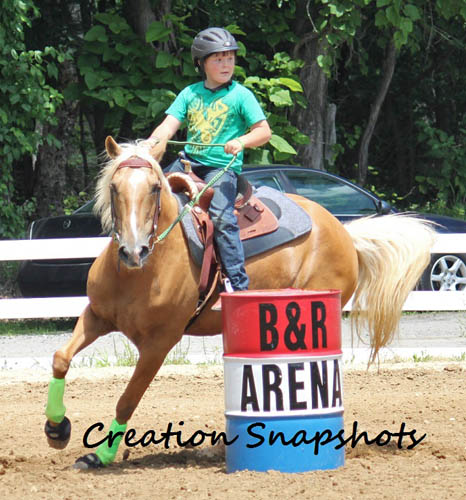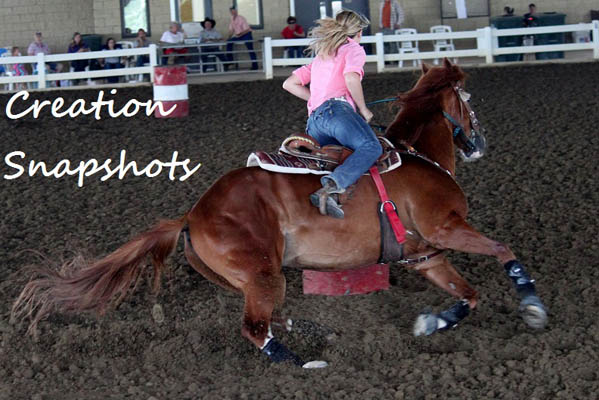So, You Think You Love Horses?
Some Reflections on the Nature of Horses and Man
More Discussions by The Accidental Horseman
Barrel Racing
Barrel Racing
(Creative Snapshots)

|
Human Beings are by nature competitors, both men and women. We enjoy becoming proficient and then matching that proficiency against others. Horses understand this as well. I recall the story of the one Thoroughbred race horse that came in second but none-the-less took himself to the winners circle and had to be physically removed with great difficulty. If you and your horse are looking for a challenging sport that is within the reach of an amateur rider you might look into barrel racing.
Barrel Racing Course
|
| 
|
Barrel racing is a popular rodeo event. The horse and rider run a clover-leaf pattern around preset barrels, placed in a triangle pattern in the center of an arena, in competition for the fastest time. Under some rules of competition, if a barrel is knocked over there is a five seconds time penalty for the rider. For example, a time score in competition might be 16 seconds and that 5 second penalty is adequate to knock the rider out of contention. However, there are even stricter competitive rules, for example those of the National Barrel Horse Association, stipulate that a rider who knocks over a barrel or who falls or whose horse falls will receive a score of zero. Winning at barrel racing requires a horse that is both fast and maneuverable and a rider who is supple and can think fast. In the professional rodeo circuit the event is often reserved for female riders. However, in other venues; for example, at youth and amateur levels in the U.S. boys or men compete. The general attitude among current barrel racers is that a person's ability and not their gender is what is important.
Barrel racing developed in the American West and most likely in Texas as a rodeo event for female riders. During the Second World War most of the younger males were inducted into the armed forces and women found themselves running ranches and filling in jobs that traditionally were considered male roles. With so many of the men gone women also had a more prominent role in those rodeos that were still held. At the end of the war the female competitors felt that they were being pushed back into beauty queen roles and that rodeos were not interested in events featuring female competition or athleticism. The answer was to come together and form an organization that was originally called the Girls Rodeo Association, established in 1948. Long before Title IX (1972) sought parity for female collegiate athletics, GRA (now renamed Women’s Professional Rodeo Association) launched a successful campaign on behalf of female competitive participation in rodeos. Today’s riders owe a great deal to the efforts of these determined women. However, it would be wrong to think that barrel racing is exclusively a North American phenomenon. It has since developed a significant following in Europe, Australia and Asia. Particularly in China male competitors are common place and everyone is well turned-out in western wear and tack to boot.
You might be forgiven if you look at barrel racing and think to yourself, “I could do that.” Maybe you could but it really is much harder than it looks. In any sport professionals make what they do look so easy. Barrel racing is a timed event and the challenge to the rider if to rapidly turn the horse around the barrel. This involves split second timing and a subtle shift in the rider's seat backwards to the horse’s hindquarters during the turn. The horse is called upon to go from running flat out and then in a split second collect himself and make a tight turn. In short, this sport is both physically and mentally demanding for both horse and rider. It calls for a high level of physical fitness, good coaching and hours of training and conditioning.
Notice the rider leaning into the barrel.
(Courtesy: Creative Snapshots)

|
|
Side view of a horse in the turn.
(Courtesy: Creative Snapshots)

|
|
Yours truly,
The Accidental Horseman.
Back to Additional Discussions
Links to Other Sites regarding Horses
Back to Index Page


